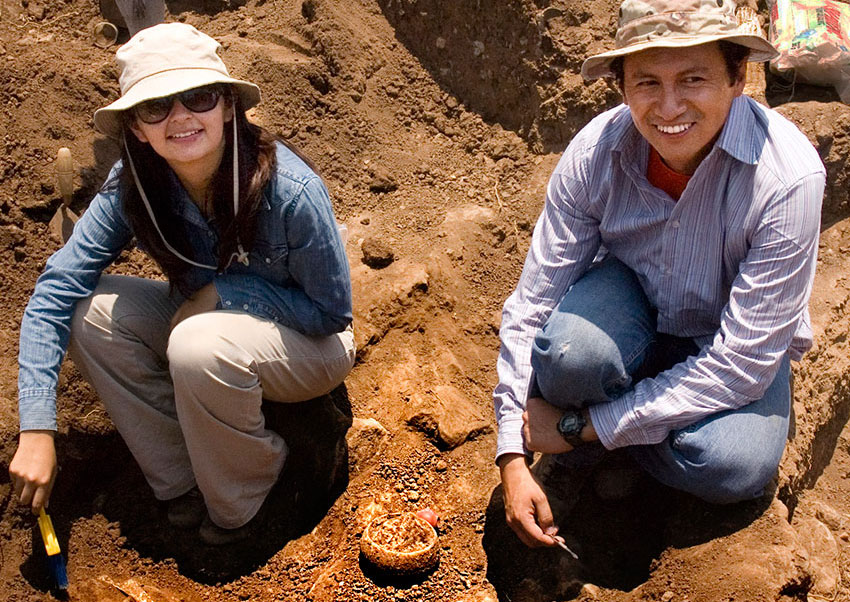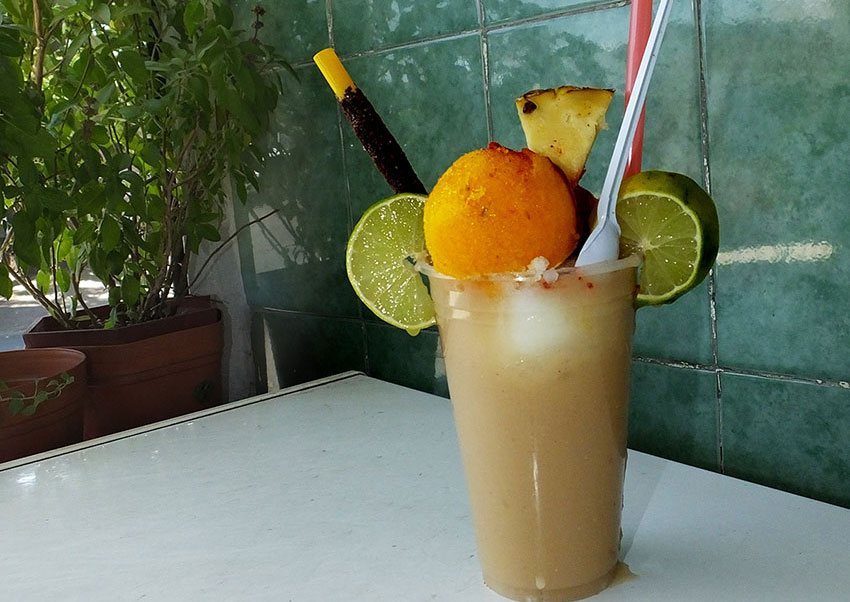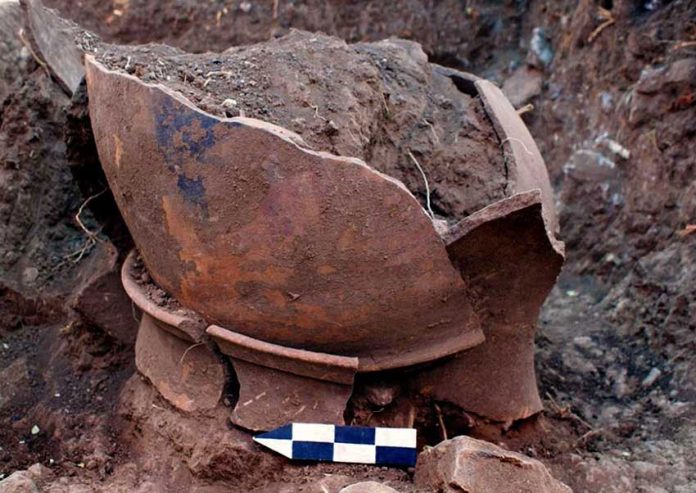His mobile rang. Archaeologist Rodrigo Esparza tapped Reply. On the other end was Cecila González, one of Mexico’s leading experts in ceramic restoration. “Guess what?” she said. “I have a surprise for you. Your jar is ready to go home.”
Esparza was indeed surprised, because he had turned some 350 fragments of the huge clay pot over to Guadalajara’s highly respected Escuela de Conservación y Restauración (ECRO) 12 years earlier and had almost forgotten about it.
The story began in 2008, when Esparza and other archaeologists were hard at work excavating a plot of land just south of western Mexico’s 2,000-year-old Guachimontones circular pyramids. The site had been chosen for the construction of a large interactive museum.
“We chose that land,” Esparza told me, “because we believed there was nothing of archaeological importance there, but we could not have been more mistaken.”
Naturally the archaeologists decided to check their assumptions and as soon as they began digging beneath the surface, they discovered that a 10-square-meter section of the new museum site was unusually rich in artifacts. Within a few months they unearthed bowls, jewelry, figurines, six burials, five ovens and six big urns, one of them a meter high by a meter wide.

“Something curious happened when we first peeked into the biggest urn,” I learned from archaeologist Cyntia Ramirez, then head of field operations. “We started out slowly removing the top layers of dirt inside the pot, which appeared to be at least 500 years old and, to our surprise, we began to pull brightly colored strands of cloth out of it, which didn’t look the least bit ancient. It didn’t take long to discover that the fabric came from a colorful sock which had been stuffed into the container by a modern pack rat.”
“What most amazed us,” explained Rodrigo Esparza, “was that within this little 10-meter square, we found numerous pieces from every archaeological period from the pre-classic to the post-classic. This was highly important, as it seemed to indicate that — contrary to our previous beliefs — the Teuchitlán civilization did not suddenly die out. It’s obvious that this site had been continuously inhabited for over 2,000 years.”
The more they thought about it, the more the archaeologists were puzzled by the six large urns. At first they thought they might find burials, perhaps of children, in some of them, but — except for the pack rat’s sock — they were all empty. What were such large containers doing in what seemed to be typical homes of 500 to 700 years ago?
Phil Weigand, “the discoverer of the Guachimontones,” suggested that they were not funerary urns, but jars used to ferment and store tejuino, a tart beer made from sprouted corn which is still popular in some parts of Mexico. Weigand pointed to the degraded insides of the pots which he suggested had been affected by stirring with wooden paddles and by the alcohol content of the corn beer.
The Guachmontones archaeologists carefully gathered together the 350 pieces of the largest jar and took them to ECRO, which is located in downtown Guadalajara.
“We knew that restoring this jar was going to be very challenging and difficult,” Rodrigo Esparza told me, “so, instead of submitting it in a normal way — which would have cost a lot of money — it was placed in a special program designed for students doing their social service. So the pot was restored bit by bit by over five generations of students who not only put the pieces together, but also studied the pot from every angle, investigating its purpose and what it contained.”

This provoked so much interest that one of Esparza’s students at the Colegio de Michoacán, Miguel Novillo, decided to do his thesis on what he calls the Guachimontones Fermentation Jars (tinajas de fermentación).
Scraping off the sediments at the bottom of these pots, Novillo did a chemical analysis, revealing the presence of carbohydrates and starches from maize (Zea mays). “I should mention,” says Esparza, “that this analysis showed that those starches had to have been boiled.”
Novillo also found starch from camotes (sweet potatoes) which, he suggested, had been added because they contain a high percentage of sugar, which would have sped up the fermentation process. A variety of analyses proved that some of these jars were used over a fire for cooking tejuino, while others were employed for the fermentation process and still others for storage of the final product. It was also proven that these jars could not have been used to store water or grain.
It is interesting to note that the big jar found in 2008 weighs about 100 kilos empty, so that when it was full of liquid it must have weighed around 200 kilos (441 pounds).
“It may seem surprising,” Esparza told me, “but it appears that jars of this size were commonly used in those days and every home may have had not just one, but two or three jars this size. I should mention, by the way, that in our excavations we have normally found these pots all in pieces, not well preserved like our big jar, which we found 85% intact.”
More studies may determine whether tejuino was the staple drink of every family or was reserved for what Phil Wiegand called mitotes, fiestas similar to those which the Huicholes still hold today.
[soliloquy id="109517"]
After 12 years of studies and restoration, the Guachimontones Fermentation Jar was in process of being packed up for shipment to the Guachimontones Interpretive Center when Covid-19 struck. ECRO was forced to close its doors and the museum stopped receiving visitors.
“When things go back to normal,” commented Rodrigo Esparza, “the jar will be delivered to the museum and we hope to create an exhibition on tejuino and the other fermented drinks used in pre-Hispanic times and during the first years of the colonial period.”
Tejuino, I should add, was not only popular in pre-Hispanic times, but is still a favorite hot-weather drink in Jalisco, Chihuahua and other places. To find out how it’s made, I had only to drive five minutes from my home outside Guadalajara to the nearest tejuino stand (in the town of La Venta del Astillero), where tejuino brewer Osmar Carmona outlined the procedure:
“First we remove kernels from the corncob and wet them until they sprout. Then we put them into a pot and add water and cal (powdered lime). This we boil, cover, and allow to cool overnight. Now we drain the liquid, rub the fibrous hull off the kernels of corn and grind up the inner parts. Finally we add piloncillo [Mexican brown sugar] and boiled water and give this a chance to ferment a bit.”
To the resulting cappuccino-colored beverage Carmona adds lime juice, scoops of mango and lemon nieve (sorbet) and, of course, a sprinkle of chile powder.
Osmar Carmona’s tejuino is for family use and he says it contains no alcohol, but other tejuino sellers allow the drink to ferment more than “a bit” and it could have an alcohol content of 4-5% This stronger version of the drink is called tesgüino which, for the Rarámuri (Tarahumara) and other groups, is and has always been a sacred, ritual beverage.
“El tejuino is not only refreshing, it’s good for your health,” Carmona told me as he handed me my bebida. “If you drink it regularly, it will replace the pathogenic bacteria in your colon with probiotics: live bacteria and yeasts that are good for you and will keep your tripas healthy.”
It looks like tejuino may be just the thing to wash down other pre-Hispanic superfoods like amaranth, chía and spirulina.
The writer has lived near Guadalajara, Jalisco, for more than 30 years and is the author of A Guide to West Mexico’s Guachimontones and Surrounding Area and co-author of Outdoors in Western Mexico. More of his writing can be found on his website.
